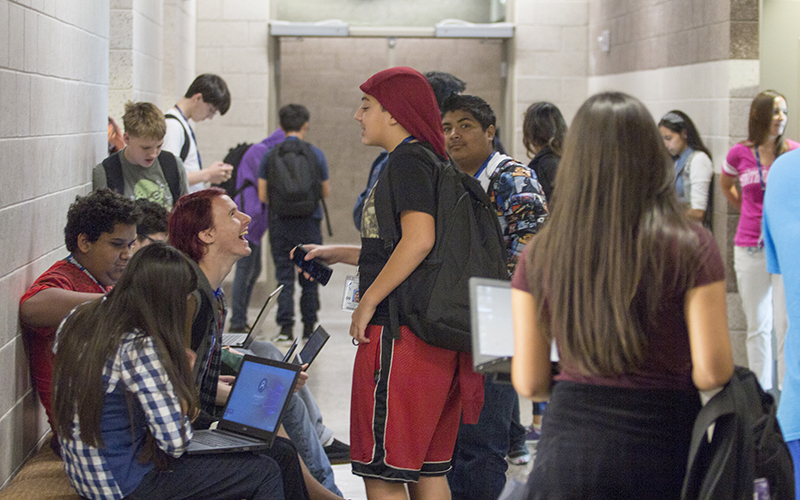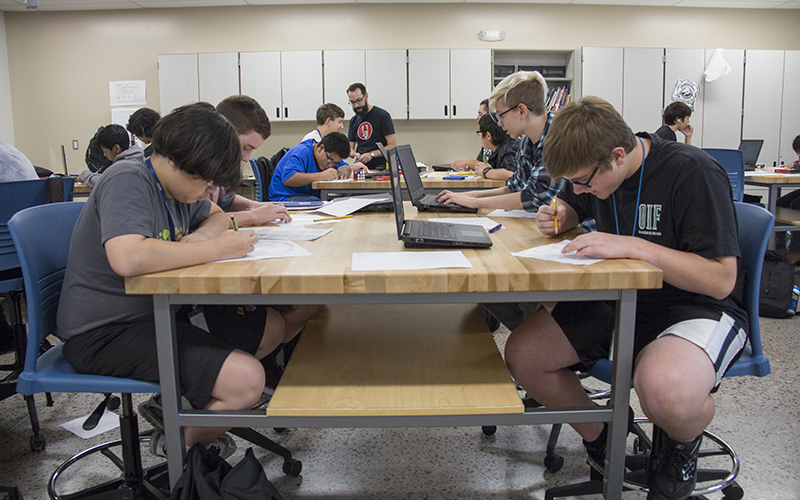PHOENIX – When you imagine what class at Phoenix Coding Academy might look like, maybe you think of students staring at endless rows of characters and symbols on computer screens.
And sure, sometimes that happens.
But you’re just as likely to find students hunched over their desks with colored pencils and markers in their hands.
On a recent school day, students pushed their laptops to the center of their desk, clearing the space to work on a different kind of assignment: Design their own album cover.
At the academy, the newest school in the Phoenix Union High School District, administrators put just as much emphasis on art as they do on engineering.
“Art is essential,” Principal Seth Beute said. “Creativity is really important in computer science and problem solving. When you think about building new apps, new programs, new industries altogether – we know the students are going to be working on something we’ve not even heard of yet.”

Seth Beute, principal of Phoenix Coding Academy, said “computer science is extremely important” in today’s job market. (Photo by Ally Carr/Cronkite News)
Phoenix Coding Academy opened its doors in August to prepare students to enter college or the workforce with the skills they need to succeed, no matter what career path they choose, administrators said. The first class has 90 students who will graduate knowing how to build apps, collaborate in teams, develop video games and program robotic arms.
Computer science related jobs, like programming, coding, network security and software engineering, are on the rise in Arizona, according the the Bureau of Labor Statistics, yet industry recruiters say there aren’t enough qualified workers to fill all the open positions. This school is one of a few ways Arizona groups are addressing this shortage by getting students interested in the field early.
“Computer science is extremely important,” Beute said. “When we look around and see all the technology and the advancements related with technology, there will continue to be openings in the industry and a lot of opportunities. Some will require college and some won’t, that’s just the reality of this field, so we want all of our students to be college ready and career ready so they’ll have options.”
Those career options don’t seem to be going anywhere any time soon. Computer and information technology jobs are the fastest growing job field in the U.S., projected to add nearly half a million jobs to the market by 2024, according to the Bureau of Labor Statistics. Arizona in particular has seen a lot of this growth.
Computer Science Employment Growth in ArizonaVenngage Infographics
Many technology companies are moving to Arizona because of the available real estate and incentives from the state of Arizona, said Donna Dietrich, the divisional managing partner at Arizona Tech Finders, a technology staffing firm.
Finding the talent to fill all those new jobs can be challenging.
“The best of the best are typically gainfully employed,” Dietrich said. “We do have people who are obviously applying for roles, but the demand is higher, the supply is less. It hasn’t kept up with the rate of … people they need in technology.”
Some jobs, like software development, can take longer to fill than others because these developers tend to already have a good job, she said. It is also difficult for candidates to stay competitive, since technology changes so rapidly potential employees need to keep up with software, apps or tools that may have only existed for a month.
“Demand and supply take time to equalize,” said Ashish Amresh, assistant professor of computer science at Arizona State University. “There’s definitely the sentiment that we’re not producing enough computer scientists, software engineers or information technologists on our own in this country.”

Alba Leon (left) and Emyli Hinojosa are in Phoenix Coding Academy’s first class of 90 students who will graduate knowing how to build apps, collaborate in teams, develop video games and program robotic arms. (Photo by Ally Carr/Cronkite News)
In 2015, there were 6,300 more people employed in computer and technology jobs in Arizona than the previous year, according to data from the Bureau of Labor Statistics. Now, there are nearly 10,000 open computing jobs in Arizona, which is 2.8 times the state’s average demand rate for job, according to data from Code.org. On top of that, Arizona produced fewer than 500 computer science graduates in 2014, but that trend may not hold.
There are several organizations that plan to help close the gap.
Grand Canyon University is working with the Science Foundation Arizona and Code.org to train elementary school teachers how to teach the basics of computer science to their students using Code.org curriculum. The university will host the first of these six-hour training classes on Oct. 22.
A new advanced placement course in computer science principles has launched this school year for high school students, according to the College Board. The groups will offer additional training for AP high school and middle school teachers as well.
Other computer science educational opportunities include Game Camp, a summer program at ASU for middle and high school students to design video games. Amresh, who thinks everyone needs to learn basic programming and computing skills, founded the camp.
“That’s really important in the society we live in,” he said. “You don’t have to pursue a career in computer science to know a little bit about computing because no matter what field you’re in, understanding how technology works, how programming and software interplay, that is an essential 21st century skill. It’s almost as important as knowing a second language.”

Students gather between classes at Phoenix Coding Academy, which opened its doors in August. (Photo by Ally Carr/Cronkite News)
Back in the art class at Phoenix Coding Academy, students at one table draw and joke with one another. No matter what career students pursue, understanding computers and working in teams are essential skills principal Beute wants them to learn. One student wants to use what he learns to solve some of the mysteries of the universe.
“I want to go into physics … specifically astrophysics,” said Michael Colonica, a freshman student. “I enjoy looking at the stars, and I think space is just an interesting place with many question marks everywhere.”
Fifteen minutes later, class lets out and the halls reverberate with loud chatter. The students have a few minutes to decompress before heading to their next class.
In an empty classroom upstairs, 3-D printers and a robotic arm wait for students to learn how to program them and bring them to life.
